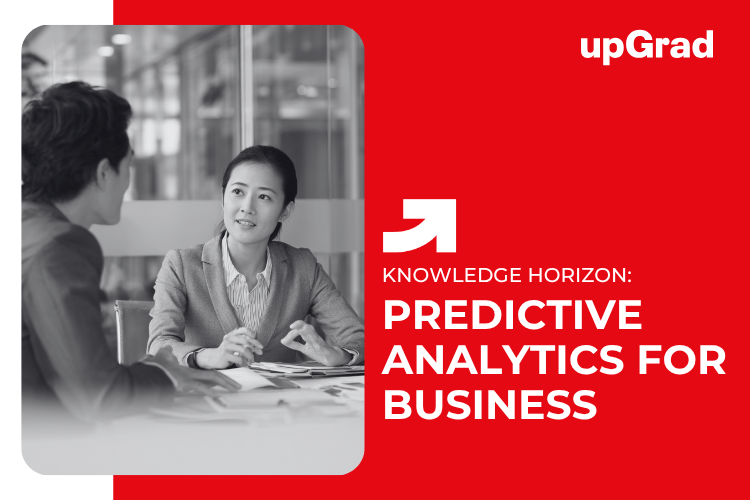Predictive analytics is a critical concept for machine learning and data science professionals. It has completely transformed data-driven business strategies by empowering organizations to anticipate future trends and optimize decision-making. Companies are gaining a competitive edge by learning to forecast future trends and identify potential risks/opportunities early on.
For example, if you’re in the retail business, you’ll know that seasonal demand is a norm at particular times of the year. With predictive analysis AI models, retailers can stock the right products at the right time without shortages or wastage. Interestingly, 70% of global companies use generative AI in at least a single business function. 92% also reportedly plan to scale up their AI investments in the next three years. It naturally hints at the growing importance of predictive analytics across sectors. Let us take a closer look at the same below.
Also Read: How Data Science is Transforming Real-World Decision-Making in the US
Understanding Predictive Analytics and How It Works?
There are various techniques in descriptive and prescriptive analytics. The former concentrates on the happenings in the past, while the latter forecasts what may happen in the future. Prescriptive analytics also determines what to do to achieve the desired outcomes.
Data Collection
Predictive analytics works by gathering data from multiple sources as the first part of the process. Some of these sources include internal databases, external data providers, and even customer/public inputs. Once collected, the data is compiled and sent for preparation.
Data Preprocessing
The next step is cleaning the data and ensuring its accuracy and usability in terms of format. Cleaning and organization are essential to making the data fit for creating predictive models. In this step, raw data is transformed into analysis-ready data.
Model Selection
Statistical models are then built, and ML algorithms are deployed to analyze data patterns. The final model is selected thereafter. This process is based on factors like the business problem, preparing and exploring the data, choosing the right algorithm, evaluating the models, etc.
Training and Validation
Model training is the next part of the process, along with thorough testing and final validation of its performance and accuracy. Test datasets are used for this purpose. They are mostly unseen data since this helps understand whether models can generalize to newer scenarios without overfitting.
Deployment
The final deployment is where the model makes predictions about various outcomes. These go through an extensive analysis process to enable better decision-making. A trained predictive model integrates into a business/production ecosystem, shifting to the live operational stage from the development stage.
Key Applications of Predictive Analytics in Business
Predictive analytics has numerous applications across business sectors. Here is a look at some of them.
|
Industry |
Applications |
| Banking |
|
| Retail |
|
| Predictive Analytics in Healthcare |
|
| Manufacturing |
|
| Delivery Services |
|
Also Read: Data Science for Business
Benefits of Implementing Predictive Analytics
Here are some of the advantages of implementing predictive analytics:
Better Decision-Making
Companies can better understand complex issues and make more informed decisions based on insights. They can also identify patterns/trends and anticipate future events.
Higher Productivity & Efficiency
Predictive analytics can optimize business workflows and processes, enabling higher efficiency and productivity.
Improved Customer Experiences
Customer-facing businesses can personalize customer interactions, tailoring offerings to match their specific requirements. They can also identify at-risk customers and implement targeted strategies for combating churn.
Mitigating Risks
Predictive analytics also plays a vital role in identifying potential vulnerabilities/risks and predicting future system failures.
Competitive Advantage & Savings
Businesses can leverage predictive analytics to gain a competitive edge over rivals by anticipating trends and making data-driven decisions. They can also reduce costs by preventing wastage, equipment breakdowns, inefficient stocking, etc.
Also Read: Dissertation vs Thesis: Understanding the Key Differences
How upGrad Can Help You Master Predictive Analytics
upGrad offers a wide range of data science courses that help you master concepts like predictive analytics and other vital topics like ML, AI, Python, Tableau, and SQL. Here are some other benefits of choosing these programs from upGrad.
- Flexible and 100% online courses from leading global universities with prestigious certifications.
- Hands-on projects, expert-led programs, innovative learning modules, and career support.
- Industry-oriented and relevant curricula and exposure to diverse practical scenarios for solving real-world problems.
Also Read: How to Become a Data Engineer
Learn more about predictive analytics through these machine learning and data science courses from upGrad!
- Master of Science in Data Science
- Post Graduate Diploma in Data Science (E-Learning)
- Executive Diploma in Data Science and AI with IIIT-B
- Executive Post Graduate Certificate Programme in Data Science & AI
For more information, email globaladmissions@upgrad.com or call +1 (240) 719- 6120.
FAQs on What is Predictive Analytics and Its Role in Business Strategies
Q: Which industries benefit most from predictive analytics?
Ans: Several industries derive considerable benefits from predictive analytics. Top sectors include healthcare, banking, manufacturing, delivery services, and retail.
Q: What distinguishes predictive analytics from other types of analytics?
Ans: Predictive analytics is different because it focuses on anticipating future outcomes based on current and historical data. This is a departure from other types of analytics, which mostly focus on understanding past data and patterns.
Q: Do I need a technical background to learn predictive analytics?
Ans: You don’t always need a technical background to learn predictive analytics. Although it helps, many people successfully venture into this field from diverse educational/professional backgrounds. Of course, problem-solving, critical thinking, and quick-learning skills will help you master analytics.
Q: What are examples of predictive analytics?
Ans: Predictive analytics uses algorithms and data to successfully forecast future outcomes. Some examples include risk modeling, sales forecasting, customer churn prediction, and fraud detection.
Q: What tools are commonly used in predictive analytics?
Ans: Various tools are useful for predictive analytics functions, including IBM SPSS, H20.ai, Microsoft Power BI, Alteryx, and RapidMiner. Some other tools, like Qlik and Tableau, are also helpful for business intelligence and data visualization.









